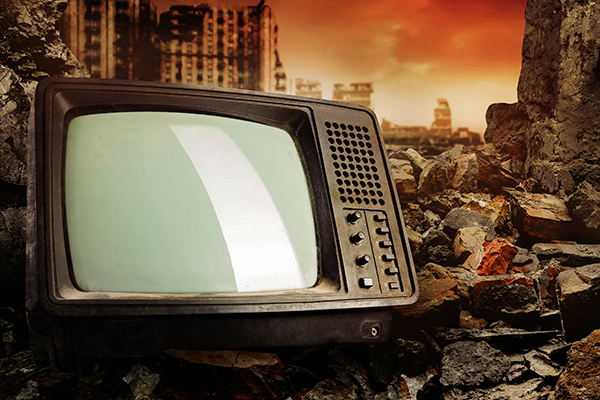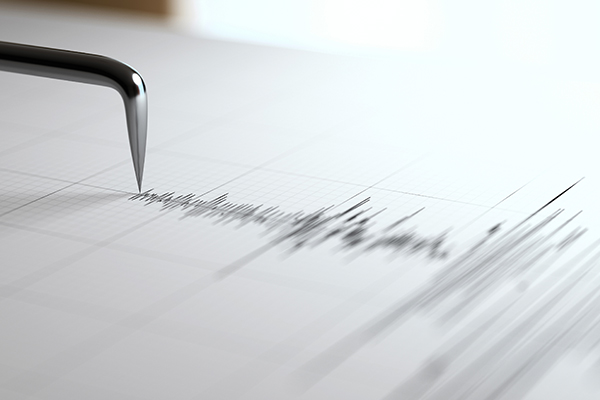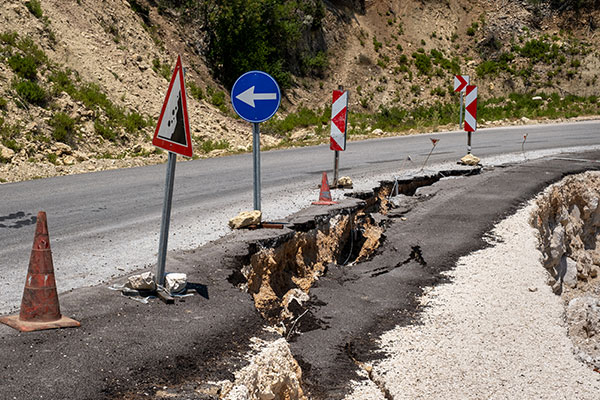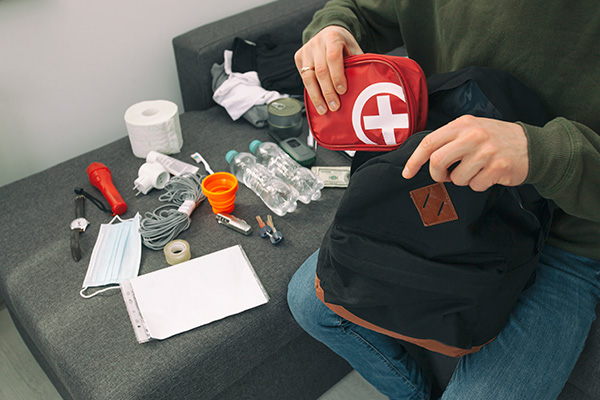According to the USGS, earthquakes can feel differently depending on where you’re located, where the earthquake originates from, and how big the earthquake is.
In this blog, we’ll explain what an earthquake feels like so that you can prepare yourself and your family for experiencing the next quake with more knowledge and a little less anxiety. We’ll also explain exactly what you can do before the ground begins to shake to reduce your home’s vulnerability to earthquake damage. Every day is earthquake season in California - read on to find out what actions you can take to be more prepared for the next big one.
Beyond the Movies: Debunking Earthquake Myths
First, let’s address an important earthquake myth, which is how earthquakes are commonly shown in movies. Hollywood tends to exaggerate the visual and physical impacts of earthquakes. Movies often show scenes of the ground splitting open, gigantic buildings completely collapsing, and widespread damage and destruction. But is this accurate?
According to the website History vs. Hollywood, no, it’s not. In their article about the movie San Andreas, they quote Seismologist Lucy Jones, who says “that the level of destruction is over-the-top” as “new buildings are designed to be able to withstand large scale quakes, at least to enough of a degree that people would be able to escape.”
An LA Times article called “Is ‘San Andreas’ real?” agrees with this take, and quotes the former President of the Earthquake Engineering Research Institute, Farzad Naeim, who also explains that a big earthquake is “not going to be Armageddon. The toppling of buildings is very rare.”
While Hollywood movies may make it seem like a large earthquake would look and feel like the end of the world, the reality is that many earthquakes in California and around the world come and go relatively peacefully. In real life, people’s earthquake experiences depend a lot on factors like the earthquake’s magnitude (the earthquake’s size) and the person’s distance from the earthquake’s epicenter (where the earthquake started).
On the other hand, it is important not to underestimate the devastation earthquakes can cause, especially in California which is the second most seismically active state in the USA. According to the California Department of Conservation, “Each year, California generally gets two or three earthquakes large enough to cause moderate damage to structures (magnitude 5.5 and higher).” One of the most damaging recent quakes in California history, the Northridge earthquake in 1994, killed 57 people, injured 9,000, and caused up to $40 billion in damage. Another devastating quake in recent California history happened in Loma Prieta on October 17th, 1989, killing 62 people and causing over $6 billion in damages.
The Stages of an Earthquake: From Subtle Shift to Violent Shaking
During an earthquake, anyone close enough to the quake’s epicenter is likely to experience a range of sensations, which can change during the course of the actual earthquake itself.
Large earthquakes tend to produce three different types of seismic waves, including P-waves, S-waves, and surface waves. We wrote about these waves in detail in our blog “How Earthquakes Cause Damage and Destruction,” but here’s a basic summary:
- P-waves travel the fastest, and tend to produce a sensation that feels like a “jolt” or a “thump.”
- S-waves, which travel more slowly, are commonly reported to feel like a “rolling” or “swaying” motion.
- Surface waves, which are usually only produced by larger earthquakes, can shake the earth from side to side or cause the ground to churn under and over like rolling ocean waves.
- Larger earthquakes usually produce bigger seismic waves, more intense experiences, more damage and more destruction. But the size of the earthquake is only one factor that influences what it feels like. Location also plays a vital role in how an earthquake feels.
Location Matters: How Distance from the Epicenter and Fault Rupture Affects the Experience
The USGS notes that typically, people closer to the fault rupture of an earthquake tend to experience stronger shaking, and they also have a higher chance of experiencing additional effects like ground tilting. The rupture will start at the epicenter and continue in one or two directions. Your distance from the earthquake’s fault rupture can play a major role in how you experience an earthquake, with the USGS describing the impact of distance as follows:
For large earthquakes:
- Large nearby earthquakes “will feel like a sudden large jolt followed quickly by more strong shaking that may last a few seconds or up to a couple of minutes if it’s a rare great event. The shaking will feel violent and it will be difficult to stand up.”
- Large far away earthquakes “will feel like a gentle bump followed several seconds later by stronger rolling shaking that may feel like sharp shaking for a little while.” The initial “gentle bump” is the impact of the faster-moving P-wave, while the later, “stronger rolling shaking” is caused by S-waves.
For small earthquakes:
- Small nearby earthquakes “will feel like a small sharp jolt followed by a few stronger sharp shakes that pass quickly.”
- Small far away earthquakes “will probably not be felt at all, but if you do feel it, it will be a subtle gentle shake or two that is easier to feel if you’re still and sitting down.”
In other words, your experience of an earthquake will depend on how close you are to the fault rupture. As you might expect, usually the closer you are, the stronger the sensations are likely to be and the farther you are, the weaker the sensations are likely to be.
Beyond Shaking: Other Experiences Associated with Earthquakes
Earthquakes don’t just cause the ground to shake; they can also create a variety of other experiences, including sounds, ground movements other than shaking, and even psychological or emotional effects.
Rumbling and Roaring: Hearing the Earth's Tremors
Earthquakes commonly produce a variety of noises, including rumbling, roaring, or booming sounds. The USGS explains that earthquakes can create these noises even in areas where no vibrations are felt. You can listen to a variety of earthquake recordings on the Seismological Society of America website, which provides a collection of 21 earthquake-related sounds recorded by Karl V. Steinbrugge.
The USGS website offers another page where you can listen to a variety of earthquake sounds that were produced by “convert[ing] the shaking during earthquakes to sound.” Their YouTube channel also hosts an educational video that can help you learn to distinguish the difference between the sound of an earthquake from other noisy events like rock avalanches and volcanic eruptions.
While many people report hearing earthquakes before they hit, this is technically impossible, as seismic waves travel faster than the speed of sound. In fact, as this documentary project Noise from Iceland reports, “By the time audible sounds associated with the earthquake become perceptible, the shaking and movement have typically already commenced. Therefore, sound serves as an aftermath of the seismic activity rather than an early warning.”
However, it’s still important to listen for warning signs of impending earthquakes, like the cell phone alerts produced by Earthquake Warning California, which uses ground motion sensors to detect earthquakes before humans can feel them.
Speaking of early earthquake warnings, did you know that the MyShake app can send your phone warnings that earthquake shaking is imminent? Download the free app today, and you could have precious seconds of warning to protect yourself and others and “Drop, Cover, and Hold On” before the ground starts to shake.
Ground Shifting and Lurching: Feeling the Earth Move
Under certain conditions, earthquakes can cause the ground to do much more than simply shake or roll. Sometimes, earthquake-induced motion can cause the ground to feel like it’s shifting, lurching, or even turning from a solid to a liquid.
Via the process known as liquefaction, earthquakes can turn loosely packed, water-saturated soil into an actual liquid. When this occurs, the soil loses its density and its ability to support roads, buried pipes, and even houses. The USGS website reports that “Liquefaction occurring beneath buildings and other structures can cause major damage during earthquakes.”
Be Prepared, Not Scared: Take Action for Earthquake Safety
You can significantly reduce your earthquake risk by retrofitting your home, and you can reduce the costs of that retrofit by securing a grant from CRMP. We have two earthquake retrofit grant programs for qualifying CA homeowners in high-risk areas, including the Earthquake Brace + Bolt (EBB) grant program and the Earthquake Soft-Story (ESS) grant program.
Even if you don’t qualify for a retrofit grant, we encourage you to invest in a retrofit for your home to help protect against earthquake damage. Scientists predict a high likelihood of a major earthquake in California within the next 30 years*, and homes built before 1980 are especially vulnerable. Retrofitting can help protect your family and help to significantly reduce potential repair costs, which could range from tens to hundreds of thousands of dollars. Strengthening your home against earthquake damage can be a lot less expensive than repairing your home or being forced to leave after a quake.
Also, you can still help protect yourself and your family from the risks of earthquakes by reading our articles on Earthquake Emergency Kits and Earthquake Safety Tips and by downloading the MyShake app. Remember that the best time to start preparing for the next major earthquake is long before the ground begins to shake!
Visit our Seismic Strong Blog for more tips, advice and information about earthquakes.
* According to the third Uniform California Earthquake Rupture Forecast (UCERF3) report.





